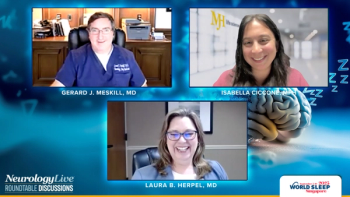
Neuro-News Roundup: Headache – Expert Perspectives and Latest Literature
Get caught up on some of the latest news in headache and migraine, with data updates and expert insights, all in one place from the NeurologyLive® team.
In recent weeks and months, the NeurologyLive® team has been hard at work conducting interviews with experts and covering the news on the latest updates in the clinical care of individuals with headache disorders, including migraine, status migrainous, posttraumatic headache, and others. Additionally, with the annual meeting of the American Headache Society taking place recently, our team gained insight from a variety of care providers from around the world about the hottest topics in the field.
To offer an update on those new developments in the literature and insight into the expert opinions about how they’re shaping the ever-changing care paradigm in headache disorders, our team has compiled some of the biggest pieces of news and exciting exchanges with physicians into one place.
Click here for more coverage of the
EXPERT INSIGHTS
Bryan Roth, MD, PhD, Michael Hooker Distinguished Professor and director of the NIMH psychoactive drug screening program at the University of North Carolina School of Medicine, recently spoke with NeurologyLive® about the available evidence in migraine and cluster headache for psychedelic agents as therapeutics. Although these drugs have shown some potential to improve headache disorders—among other conditions—there have been challenges in assessing these therapies, Roth said. Namely, in the ability to properly blind clinical trial participants in placebo-controlled trials because of the psychedelic effects of these compounds. Additionally, much of the evidence that is available in favor these drugs as therapies is anecdotal, which presents challenges for researchers in determining their actual effectiveness.
Some clinical observations have suggested that clinical endocannabinoid deficiency (CED) might be a possible migraine mechanism for a portion of the migraine patient population, though evidence in the literature has been sparse. Although, some have been conducting basic science investigations into the potential of this as a therapeutic pathway, including Tally Largent-Milnes, PhD, who spoke with NeurologyLive® about the details. Largent-Milnes, an assistant professor of pharmacology at the University of Arizona College of Medicine Tucson, detailed how the CED phenomenon has been observed in patients with chronic migraine, medication overuse headache, fibromyalgia, and irritable bowel syndrome, and how these individuals appear to have lower levels of 2 circulating endocannabinoid lipids: anandamide, known as AEA, and 2-arachidonoylglycerol, or 2-AG.
Serena L. Orr, MD, MSc, a pediatric neurologist at the University of Calgary and Alberta Children’s Hospital, spoke with NeurologyLive® about the current state of burden for patients with migraine, particularly among the children and adolescent populations. According to the World Health Organization, it is often listed among the most disabling, with the Global Burden of Disease Study placing it among the top 10 highest causes worldwide of years lost due to disability. Despite this, it remains among the least-funded disorders for research. A recent analysis presented by Orr suggested a large association between migraine and anxiety symptoms and a moderate association between migraine and depressive symptoms.
Status migrainosus, a condition in which a headache attack lasts 72 hours or longer, has posed significant clinical challenges for physicians and has placed a severe burden on the large population of patients with migraine. Currently, little literature on effective treatment options exists, with many physicians opting for a variety of approaches that are adjusted based on the situation at hand. Matthew Robbins, MD, told NeurologyLive® in a conversation that some have suggested that one of the newer calcitonin gene-related peptide (CGRP) targeted therapies, eptinezumab (Vyepti; Lundbeck), could be a potential treatment for these individuals. He also offered his insight into the overall challenge and the state of treatment for status migrainosus.
LATEST LITERATURE
Schooling Changes During COVID-19 Pandemic Suggestive of Improved Headache Coping Ability for Pediatric Patients
New data from a retrospective analysis of children and adolescents who attended outpatient visits for new onset headache at the Children’s Hospital of Philadelphia (CHOP) suggest that the changes in schooling during the COVID-19 pandemic may have affected how these patients cope with headaches.1
In total, the assessment included 8528 unique individuals aged 5 to 21 years (mean age, 12.9; SD, 3.5) and data showed that of all the variables assessed—the presence of COVID-19, age, presence of schooling, the interaction between school and COVID-19, and headache frequency—headache frequency had the most pronounced effect on Pediatric Migraine Disability Assessment (PedMIDAS) scores. Compared with those who experienced headaches on a less-than-weekly basis, those who had continuous headaches, 3 headaches or more per week, or 1 to 2 headaches per week all had a significantly increased chance of reporting higher scores.
Benefits Observed With Second Dose of Eptinezumab in Chronic, Episodic Migraine
Data from a post hoc analysis of the pivotal phase 3 PROMISE-1 and -2 studies (NCT02559895; NCT02974153) of eptinezumab (Vyepti; Lundbeck) showed that a second dose of the monoclonal antibody may benefit those with suboptimal first-dose response.2
Lead investigator Jack Schim, MD, codirector, The Headache Center of Southern California, and colleagues specifically looked at weeks 13 to 24 of treatment with eptinezumab in patients with migraine initially reporting a suboptimal response to the therapeutic over the previous 12 weeks. Patient-reported outcome data were available at weeks 12 and 24, with both 100-mg and 300-mg dose groups pooled. In total, 46.8% and 44.7% of those in PROMISE-1 and -2 had suboptimal first-dose response and were thus included in the analysis.
Aberrant Sleep Patterns Show Risk Associated With Status Migrainosus Recurrence
A study of the overall age- and sex-adjusted incidence of status migrainosus in Olmsted County, Minnesota, identified that the incidence rate of the migraine condition was 26.60 per 100,000 individuals, with an estimated 15% of the cohort experiencing a recurrent attack of status migrainosus over the following 12 months. Notably, too much or too little sleep showed potential predictive ability of status migrainosus recurrence.3
The data collected included incident cases identified as the first physician-encountered case in the record from January 1, 2012, to December 31, 2017. Individuals with status migrainosus had a median age of 35 years, with 88.6% of the cohort being women. At the time of status presentation, the medications included triptans or ergotamine in 129 cases and/or an opioid-containing analgesic in 43 cases.
Cognitive Behavioral, Processing Therapies Show Favorable Results in Comorbid Posttraumatic Headache, PTSD Symptoms
Data from a single-site study (NCT02419131) of post-9/11 US combat veterans with comorbid posttraumatic headache and posttraumatic stress disorder (PTSD) symptoms showed that cognitive behavioral therapy (CBT) was superior to usual care in improving headache-related disability. Cognitive processing therapy (CPT), the third arm in the study, was efficacious for PTSD symptoms but not for headache disability.4
A total of 193 veterans were assigned to either 8 sessions of CBT for headache, 12 sessions of cognitive processing for PTSD, or treatment per usual for headache. Using the 6-Item Headache Impact Test (HIT-6) to assess headache-related disability, those who received CBT for headache reported –3.4 points lower, while patients receiving cognitive processing therapy reported –1.4 points lower.
REFERENCES
1. Lagrant B, Hershey AD, Szperka C. Headache disability in children and adolescents before and during the COVID-19 pandemic. Presented at: AHS Annual Scientific Meeting; June 9-11, 2022; Denver, CO. Front-02.
2. Schim JD, Anderson C, Brunner E, et al. Likelihood of response with subsequent dosing for patients with migraine and initial suboptimal response with eptinezumab. Presented at: AHS Annual Scientific Meeting; June 9-11, 2022; Denver, CO. P-180.
3. VanderPluym J, Mangipudi K, Mbonde A, et al. Incidence of status migrainosus in Olmsted County, Minnesota, United States: Characterization and predictors of recurrence. Presented at: AHS Annual Scientific Meeting; June 9-11, 2022; Denver, CO. OR-17
4. McGeary D, Resick PA, Penzien DB, et al. Cognitive behavioral therapy for veterans with comorbid posttraumatic headache and posttraumatic stress disorder symptoms: a randomized clinical trial. JAMA Neurol. Published online June 27, 2022. doi:10.1001/jamaneurol.2022.1567
Newsletter
Keep your finger on the pulse of neurology—subscribe to NeurologyLive for expert interviews, new data, and breakthrough treatment updates.



































